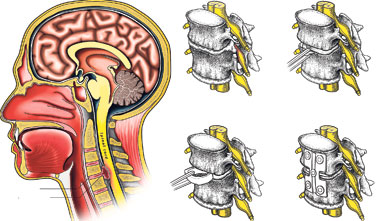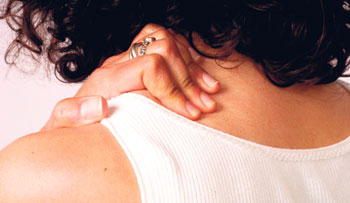Neck ache or neck pain is a common condition that affects everyone at some stage of their life.
What is neck pain?
This can be described as a discomfort or pain at the back of the neck associated with occasional stiffness in the neck muscles. The pain may radiate to the shoulder and the back of the head also causing shoulder pain and headaches.
The pain may also radiate to the arms, and be associated with numbness and tingling in the hands and arms. There maybe a feeling of weakness in the arms and tenderness in the back of the neck. Due to the pain, the posture of the neck may be altered and you may have to keep the neck slightly turned to one side.
Neck pain is more frequently seen in women than men and if it lasts for many weeks (more than three months), it maybe called 'chronic' neck pain.
Causes of neck pain
Pain in the neck can be due to a multitude of reasons:
- Mechanical pain: after an injury or trauma
- Psychological factors: stress, tension
- Arthritis in the neck: also called spondylosis
- Work related: sitting in awkward positions and using computer keyboards
- 'Slipped' discs: due to wear and tear in the neck you may get degenerative changes in the discs in the neck which cause them to prolapse and cause pain in the neck and pain in the arms. There may be associated tingling and numbness in the arms and hands as well.
- Serious conditions: infections in the neck, tumours, fractures and instability of the spine can cause acute pain which is more severe in nature and requires urgent medical attention.
Anatomy of the neck
The neck is composed of seven large bones called vertebral bodies. These are called cervical vertebrae. The two at the top are important and therefore have been give special names, the first is called the atlas and the second the axis. The atlas is given this name as it holds the head, like the god Atlas holds up the world in the famous sculpture. The axis is specially modified with a 'peg' which fits in perfectly to allow the rotation of the head.
 |
The other vertebral bodies are adapted for the same reason. In between the vertebral bodies are the discs, which are the 'shock absorbers'. Muscles and ligaments support the neck further and many tough structures called fascial layers which contain blood vessels, nerves, the gullet, and wind pipe are all protected in the neck. Exit holes in- between the vertebral bodies called foramina are the passages through which the nerves come out from the spinal cord. There are also blood vessels traversing these spaces. So as there are many structures in the neck, any pathology of these structures may give rise to pain.
Wear and tear of the vertebral bodies is the commonest cause of mechanical neck pain. Unfortunately with age all of us will suffer from arthritis of the bones in the neck giving rise to pain.
Mechanical injury may exacerbate this pain and even cause prolapse of a disc which will cause pain radiation down the arms. Mechanical injury may also cause ligamentous injury.
Treatment
If you have an injury and this is followed by neck pain which is severe, you should seek medical attention to rule out any serious causes such as fractures and instability. Otherwise the following measures can be taken.
Exercise your neck and
keep active
In the past people have been known to wear neck collars for long periods of time. This is now not recommended as immobility for long periods of time prevents you moving your neck properly. Studies have shown that you are more likely to make a speedy recovery if you do regular neck exercises and keep your neck active. This will also prevent chronic neck pain.
Pain medication
Pain relief is helpful if taken regularly till the pain eases. This also enables you to keep your neck moving. Paracetamol and anti-inflammatory drugs are the best. You must be careful not to take the anti-inflammatory tablets if you suffer from asthma, hypertension, and kidney failure.
Physiotherapy
A trained physiotherapist can advise you with regards to special exercises for your neck.
Complementary treatments
Massages, chiropractor, acupunctures, heat packs and herbal medications have all been used to relieve neck and shoulder pain. These may also help but the main thing to remember is to rule out any serious problems prior to starting these methods.
Surgery
Most neck pain is relieved by rest and simple measures as described above. For persistent neck pain and arm pain with numbness and tingling in the arms which is progressively worsening and is refractory to all other methods, surgery is an option. First the doctor after examining you will ask for some investigations to be carried out, a neck x-ray, MRI scan and routine bloods. The neck x-ray may show arthritis. The MRI scan will show a prolapsed disc causing compression of the nerve root.
There are several operations that can be carried out to relieve the pressure on the nerves. A cervical laminectomy and anterior cervical discectomy and fusion are two of the common ones.
The operation of choice to remove the prolapsed disc is the anterior cervical discectomy and fusion (ACDF). The disc material which is causing pressure on the nerve is removed and an artificial disc is put into place. If there is any concern regarding the stability of the spine a plate is placed at the front of the vertebral bodies for stability. Generally patients do very well after this operation.
The consideration of an operation must be done after all conservative methods have failed.
The outlook for mechanical neck pain is good in most cases of acute pain. Pain is usually completely resolved within a few weeks.
This varies from person to person. Other underlying medical conditions, the age of the person, repeated injury all pay a part in the time taken to recover.
(The writer is Specialist Registrar in Neurosurgery in Manchester)
If the pain persists
If the pain in the neck progressively worsens and is not relieved by simple measures you must obtain medical advice.
If there is significant tenderness of the neck and you have other symptoms such as high temperature, weight loss and generally feel ill, this maybe due to an underlying condition such as infection.
If there is fracture of the bones by minimal trauma conditions such as osteoporosis, rheumatoid arthritis and cancer must be ruled out.
Other structures in the neck other than bone may also give rise to neck pain, such as inflamed lymph nodes. In general the advice is that if you are worried about persisting pain, seek medical advice. |


